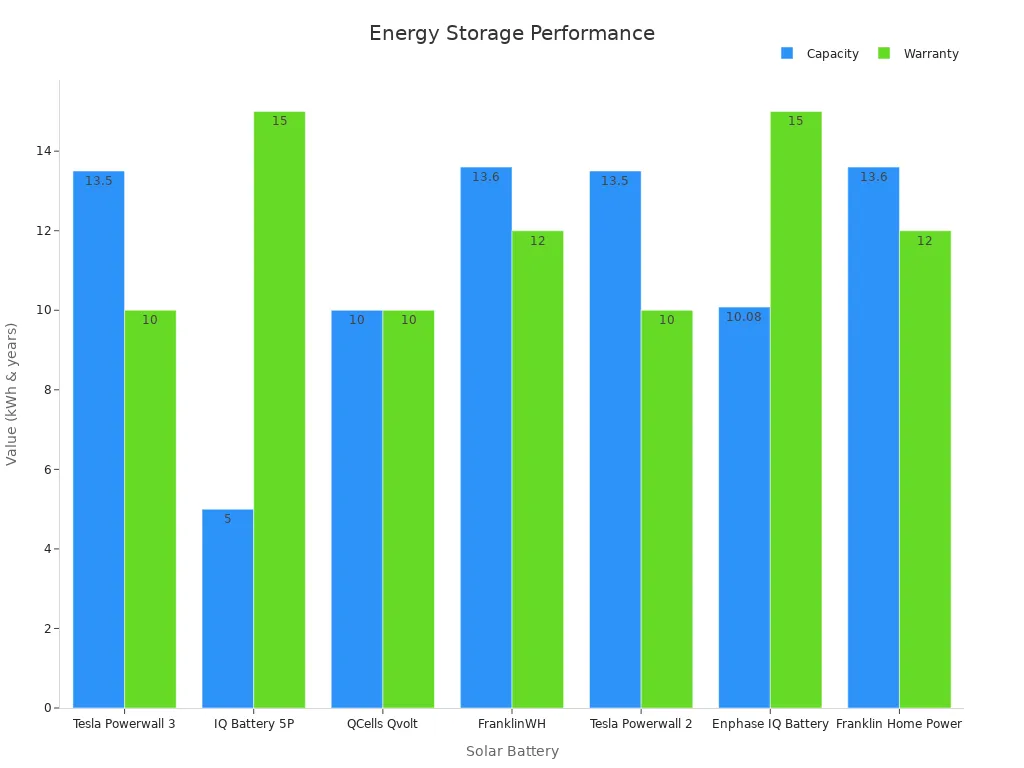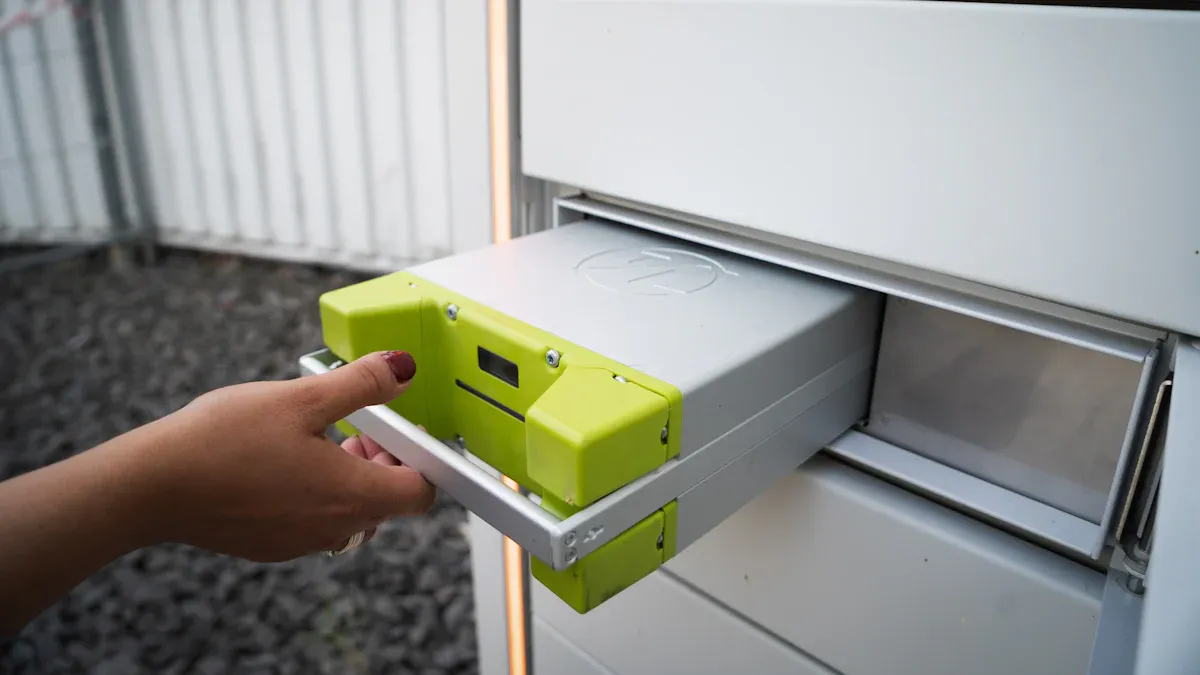Bluetti EP900 Home Battery Backup
Specifications
The Bluetti EP900 stands out as one of the most versatile battery storage systems available today. Its modular design allows you to expand capacity as your energy needs grow Here’s what makesit special:
Pros
High Output Capacity: With up to 18kW of power, it’s perfect for large homes or high-energy demands.
Fast Switching Time: Keeps your home running smoothly during outages.
Quiet Operation: At just 50 dB, it’s quieter than most other battery backup systems.
Durable Design: The IP65 certification ensures it can handle tough environments.
Future-Proof: OTA updates and IoT integration make it a smart choice for tech-savvy homeowners.
Cons
Initial Cost: The advanced features and high capacity come with a premium price tag.
Tesla Powerwall 3
Specifications
Tesla’s Powerwall 3 is a household name in the world of home solar battery systems. It combines sleek design with powerful performance. Here’s a closer look:
The Powerwall 3 also integrates seamlessly with Tesla’s app, giving you full control over your energy usage.
Enphase 5P
Specifications
The Enphase 5P is a top contender in the battery comparison for 2025. It’s known for its reliability and long lifespan. Here’s what you need to know:
Cons
Lower Capacity: At 5 kWh, it may not be sufficient for larger households.
Pro Tip: When comparing the best solar batteries, consider your home’s energy needs and whether you prioritize capacity, warranty, or advanced features.
LG Energy Solution RESU Prime
Specifications
The LG Energy Solution RESU Prime is a compact and powerful home energy storage system designed to meet your energy needs efficiently. It offers a high-capacity solution for storing solar energy, making it ideal for households with significant energy demands. Here’s what you can expect:
Pros
Smart Home Integration: It connects with your existing smart home devices for seamless energy management.
Long Warranty: A 15-year warranty ensures durability and reliability.
Eco-Friendly: The LiFePO4 battery chemistry is safer and more sustainable than traditional lithium-ion options.
Energy Optimization: Its intelligent load control helps you use energy more efficiently.
Cons
Higher Price Point: The advanced features come at a premium cost.
BYD Battery-Box Premium
Specifications
The BYD Battery-Box Premium is a versatile and high-performing energy storage system. It’s designed for both residential and commercial applications, offering flexibility and reliability. Here’s what sets it apart:
Duracell Power Center Max Hybrid
Specifications
The Duracell Power Center Max Hybrid is a powerhouse designed to keep your home running smoothly, even during outages. Its robust features make it a top choice for homeowners seeking reliability and efficiency. Here’s a breakdown of what it offers:
Pros
Scalability: You can expand its capacity by stacking additional batteries, making it adaptable to your growing energy needs.
Whole-Home Backup: Its 200A capability ensures that even high-demand appliances stay powered during outages.
Energy Optimization: By syncing with time-of-use rate plans, it helps you save money on electricity bills.
Solar Compatibility: Adding solar panels extends its runtime, making it a sustainable choice.
Generator Integration: This feature boosts reliability and ensures efficient fuel usage during extended outages.
Cons
Complex Installation: Its advanced features may require professional installation, which could increase upfront costs.
Tip: If you’re looking for a system that combines high capacity with flexibility, the Duracell Power Center Max Hybrid is a solid choice.
YouthPOWER 48V LiFePO4 Powerwall
Specifications
The YouthPOWER 48V LiFePO4 Powerwall is a compact yet powerful solution for residential energy storage. Its advanced lithium iron phosphate technology ensures safety, longevity, and efficiency. Here’s what makes it stand out:
Overcurrent Protection: Customizable to suit your specific energy needs.
Short Circuit Protection: Safeguards against external load short circuits.
Main Circuit Resistance: ≤10mΩ for optimal performance.
Self-Consumption: Working current ≤100uA, ensuring minimal energy loss.
Sleepy Current: ≤20uA when over-discharged, preserving battery life.
Temperature Range: Operates efficiently between -20°C and +80°C.
Longevity: Expected lifespan of 20 years, making it a durable investment.
Efficiency: Pays for itself in under four years, thanks to its cost-effectiveness.
Pros
Durable Design: With a 20-year lifespan, this battery is built to last.
Cost-Effective: Its payback period of under four years makes it a budget-friendly option.
Safe and Reliable: Features like overcurrent and short circuit protection ensure safety.
Versatile Compatibility: Works seamlessly with various inverters, including Growatt 5000W.
Eco-Friendly: Lithium iron phosphate technology is safer and more sustainable than traditional lithium-ion batteries.
Cons
Limited Capacity: At 5 kWh, it may not meet the needs of larger households.
Customer Insight: "This powerwall works perfectly with my Growatt 5000W inverter. Our customers love it, and it really lasts!" – David Alexander, Mexico Energy Storage
Panasonic EverVolt
Specifications
The Panasonic EverVolt is a premium energy storage system designed for reliability and performance. It’s a great choice for homeowners looking to maximize their solar energy usage. Here’s what you can expect:
Reliability: Recognized in the PVEL PV Module Reliability Scorecard for outstanding performance.
Solar Output Warranty: A 25-year warranty guarantees 92% output, ensuring long-term reliability.
Warm Weather Performance: A low temperature coefficient of -0.26%/°C ensures efficiency in high temperatures.
Pros
Long-Term Reliability: The 25-year warranty reflects Panasonic’s confidence in its product.
High Efficiency: Performs exceptionally well in warm climates, making it ideal for sunny regions.
Trusted Brand: Panasonic’s reputation for quality and innovation adds to its appeal.
Eco-Friendly: Designed to maximize solar energy usage, reducing your carbon footprint.
Cons
Premium Price: Its advanced features come at a higher cost, which may not suit all budgets.
Note: If you live in a warm climate and want a system that lasts, the Panasonic EverVolt is worth considering.
Hicorenergy Solutions
Specifications
Hicorenergy Solutions offers a cutting-edge home energy storage system designed to meet the needs of modern households. It combines advanced technology with user-friendly features, making it a reliable choice for energy independence. Here’s what you can expect:
Did You Know? Hicorenergy Solutions uses LiFePO4 batteries, which are known for their safety and long lifespan. This makes them a great choice for families looking for a durable and eco-friendly option.
Pros
Hicorenergy Solutions stands out for several reasons. Here’s why it could be the right choice for your home:
Expandable Capacity: The modular design lets you start small and add more capacity as needed. Perfect if your energy needs change over time.
High Efficiency: With a 95% round-trip efficiency, you get more usable energy from every charge. That means less waste and more savings.
Durable and Safe: The LiFePO4 battery chemistry ensures safety and a longer lifespan compared to traditional lithium-ion batteries.
Smart Features: The mobile app gives you real-time insights into your energy usage. You can monitor and control your system from anywhere.
Flexible Installation: Whether you want it indoors or outdoors, this system adapts to your space.
Tip: If you’re planning to pair your battery with solar panels, Hicorenergy Solutions offers seamless integration. This can maximize your energy savings and reduce your reliance on the grid.
Cons
While Hicorenergy Solutions has plenty of strengths, there are a few things to consider:
Initial Investment: The upfront cost may be higher than some competitors. However, the long-term savings and durability often make up for it.
Limited Availability: Depending on your location, finding an installer or distributor might take some extra effort.
Pro Tip: Before purchasing, check for local installers or authorized dealers to ensure smooth installation and support.
Key Features to Consider
Capacity and Scalability
When choosing a home energy storage system, capacity and scalability are two of the most important factors to consider. Capacity refers to how much energy the system can store, while scalability determines whether you can expand that storage as your needs grow.
Here’s a quick comparison of capacity benchmarks:
These metrics highlight how different systems perform under varying conditions. A higher capacity factor means the system can store and release energy more effectively over longer periods.
Tip: If you’re planning to pair your battery with solar panels, look for systems with high scalability. This ensures you can store more energy during sunny days and use it when you need it most.
Efficiency and Round-Trip Efficiency
Efficiency is the backbone of any energy storage system. It determines how well the system converts and uses energy. Round-trip efficiency, in particular, measures how much energy you get back after charging and discharging the battery.
Here’s how efficiency is tested:
Efficiency Testing: Evaluates how effectively the system stores and releases energy.
Round-Trip Efficiency Test: Compares the energy input during charging with the energy output during discharging.
Charge and Discharge Efficiency Tests: Separately measure the energy stored during charging and the energy released during discharging.
A system with high round-trip efficiency minimizes energy loss, saving you money and maximizing performance. For example, a system with 85% round-trip efficiency ensures that most of the energy you store is available for use.
Did You Know? Systems with lithium iron phosphate batteries often have higher efficiency rates compared to traditional lithium-ion options.
Battery Chemistry (Lithium-Ion vs. Alternatives)
Battery chemistry plays a big role in how your energy storage system performs. Lithium-ion batteries are the most common choice, offering high energy density and long lifespans. However, alternatives like lithium iron phosphate (LiFePO4) are gaining popularity due to their safety and durability.
Here’s a quick comparison:
Lithium-Ion: Compact and lightweight, ideal for homes with limited space.
Lithium Iron Phosphate (LiFePO4): Safer and longer-lasting, making it a great choice for families.
LiFePO4 batteries also have a lower risk of overheating, which adds an extra layer of safety. If you’re looking for a sustainable option, these batteries are more eco-friendly than traditional lithium-ion ones.
Pro Tip: Consider your priorities—whether it’s safety, lifespan, or compact design—when choosing the right battery chemistry for your home.
Lifespan and Warranties
When choosing a home energy storage system, lifespan and warranties are critical factors. These determine how long your system will last and the level of protection you’ll receive if something goes wrong. A longer lifespan means fewer replacements, saving you money in the long run.
Here’s a quick comparison of popular models:
Tip: Look for systems with higher cycle counts and extended warranties. These features ensure durability and reliability, giving you peace of mind for years.
Integration with Solar Panels and Smart Home Systems
A home energy storage system works best when it integrates seamlessly with your solar panel system and smart home devices. This compatibility allows you to maximize energy efficiency and automate your energy usage.
Here’s a breakdown of compatibility details:
Note: If you already have a home solar system, check compatibility before purchasing a battery. This ensures smooth integration and optimal performance.
Cost and Return on Investment
Investing in a home energy storage system isn’t just about upfront costs—it’s about long-term savings. These systems help you reduce electricity bills by storing energy during off-peak hours and using it during peak times.
Here’s why these systems make financial sense:
Significant cost reductions in battery storage systems improve economic viability.
Using stored energy during peak hours lowers your electricity bills.
Pairing your battery with a solar panel system increases savings by reducing reliance on the grid.
Pro Tip: Calculate your energy needs and compare costs to find a system that offers the best return on investment. Over time, the savings can outweigh the initial expense.
How to Choose the Right System
Assessing Your Energy Needs
Choosing the right home energy storage system starts with understanding your energy needs. You need to figure out how much power your household uses daily and during peak hours. This helps you pick a system with the right capacity.
Here’s a quick overview of tools and methods:
Tip: If you’re unsure about your energy needs, consult a professional or use an energy monitoring app to get a clearer picture.
Budget Considerations
Your budget plays a big role in choosing the right system. Home energy storage systems can be a significant investment, but they offer long-term savings. To make an informed decision, you need to understand the costs involved.
Here’s what to consider:
Initial Costs: Includes the price of the battery, installation, and any additional equipment.
Long-Term Savings: Using stored energy during peak hours can lower your electricity bills.
Market Trends: The growing demand for storage systems means more options and competitive pricing.
Pro Tip: Compare different systems and calculate their payback period. A system that pays for itself in a few years is a smart financial choice.
Compatibility with Existing Systems
Before buying a battery backup system, check if it’s compatible with your current setup. If you already have solar panels or smart home devices, the new system should integrate seamlessly.
Here’s what to look for:
Solar Panel Integration: Make sure the battery can store energy from your solar panels.
Smart Home Compatibility: Systems that connect with smart devices let you automate energy usage.
Inverter Matching: Check if the battery works with your inverter. Some systems require specific models.
Note: If you’re planning to upgrade your solar panels or smart home devices, choose a system that supports future expansions. This saves you from compatibility issues down the road.
Evaluating Long-Term Savings
When you invest in a home energy storage system, you’re not just buying a battery—you’re buying years of savings. But how do you figure out if it’s worth it? Start by looking at your electricity bills. If you’re paying high rates during peak hours, a battery can help you cut costs by using stored energy instead.
Let’s break it down:
Tip: Calculate the payback period for your system. If it pays for itself in 5-7 years, you’re looking at a solid investment.
Long-term savings also depend on your energy habits. If you’re smart about when and how you use stored energy, you’ll maximize your return on investment. Plus, many systems come with warranties that last 10-15 years, ensuring reliability and peace of mind.
Choosing a Reliable Brand
Picking the right brand is just as important as choosing the right system. You want a company that stands behind its product and offers excellent customer support. Look for brands with a proven track record in energy storage.
Here’s what to consider:
Warranty: A longer warranty shows the brand’s confidence in its product. Look for warranties of 10 years or more.
Customer Support: Reliable brands offer responsive support to help you with installation, troubleshooting, and maintenance.
Innovation: Companies that invest in research and development often provide cutting-edge features, like smart home integration and modular designs.
Note: Don’t just focus on big names. Some smaller brands offer excellent systems at competitive prices.
Choosing a reliable brand ensures you’re not just buying a battery—you’re investing in peace of mind. A trustworthy company will be there for you, whether you need help with installation or have questions years down the line.
FAQ
What is a home energy storage system?
A home energy storage system stores electricity for later use. It’s like a big rechargeable battery for your house. You can store energy from solar panels or the grid and use it when needed, like during power outages or peak hours.
How do I know what size battery I need?
Check your energy usage on your electricity bill. Look at how much power you use daily and during peak times. If you have solar panels, consider how much energy they generate. A professional installer can also help you decide.
Can I add a battery to my existing solar panel system?
Yes, most systems are compatible with solar panels. Check if your battery works with your inverter and solar setup. Some systems, like Tesla Powerwall or Enphase, integrate seamlessly with solar panels for maximum efficiency.
How long do home batteries last?
Most home batteries last 10-15 years or around 6,000 charge cycles. Warranties often cover this lifespan. Lithium iron phosphate (LiFePO4) batteries tend to last longer and are more durable than traditional lithium-ion options.
Are home energy storage systems safe?
Yes, modern systems are designed with safety in mind. Features like overcurrent protection, short circuit safeguards, and temperature controls ensure safe operation. LiFePO4 batteries are especially known for their safety and stability.
Will a battery save me money on electricity?
Absolutely! Batteries let you store energy during off-peak hours when rates are lower. You can use that stored energy during peak times to avoid high electricity costs. Pairing a battery with solar panels can save even more.
Can I use a battery during a power outage?
Yes, most systems provide backup power during outages. Some, like the Bluetti EP900 or Tesla Powerwall, switch seamlessly to battery power in milliseconds. This keeps your essential appliances running without interruption.
Is it worth the investment?
If you want energy independence, lower bills, and a greener home, it’s worth it. While the upfront cost can be high, the long-term savings and benefits often outweigh the expense. Plus, many systems pay for themselves in a few years.



